Animal Kingdom NCERT
Quiz Summary
0 of 45 Questions completed
Questions:
Information
You have already completed the quiz before. Hence you can not start it again.
Quiz is loading…
You must sign in or sign up to start the quiz.
You must first complete the following:
Results
Results
0 of 45 Questions answered correctly
Your time:
Time has elapsed
You have reached 0 of 0 point(s), (0)
Earned Point(s): 0 of 0, (0)
0 Essay(s) Pending (Possible Point(s): 0)
Categories
- Not categorized 0%
- 1
- 2
- 3
- 4
- 5
- 6
- 7
- 8
- 9
- 10
- 11
- 12
- 13
- 14
- 15
- 16
- 17
- 18
- 19
- 20
- 21
- 22
- 23
- 24
- 25
- 26
- 27
- 28
- 29
- 30
- 31
- 32
- 33
- 34
- 35
- 36
- 37
- 38
- 39
- 40
- 41
- 42
- 43
- 44
- 45
- Current
- Review
- Answered
- Correct
- Incorrect
-
Question 1 of 45
1. Question
1 point(s)What would be true for an animal that exhibits the kind of body symmetry shown in the given diagram?
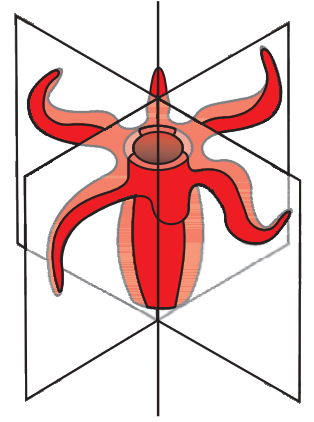
I: This is seen in sponges, cnidarians, ctenophores and larval echinoderms.
II: This type of body symmetry is generally seen in animals which move actively in their environment.CorrectIncorrectHint
(d)
🧠 Statement I
-
False. While cnidarians (e.g., jellyfish, sea anemones), ctenophores (comb jellies), and echinoderm larvae exhibit radial symmetry, sponges (Porifera) are generally asymmetrical, not radially symmetric.
⚡ Statement II
-
False. Radial symmetry is typically found in sessile (e.g., sea anemones) or slow-moving/floating animals (e.g., jellyfish, echinoderms), allowing equal interaction with the environment from all sides. However, it is not generally linked to active, directional movement—it lacks the streamlining benefits of bilateral symmetry .
-
Question 2 of 45
2. Question
1 point(s)Consider the given two statements:
Statement I: Sponges exhibit a cellular level of organization.
Statement II: Cnidarians have a tissue level of organization.
In light of the above statements, choose the most appropriate answer from the options given below:CorrectIncorrectHint
(b)
-
Question 3 of 45
3. Question
1 point(s)A complete digestive system is present in the members of all the following phyla of Animal Kingdom except:
I. Platyhelminthes
II. Mollusca
III. AnnelidaCorrectIncorrectHint
(a) Only I
-
I. Platyhelminthes (flatworms) have an incomplete digestive system—they possess a single opening serving as both mouth and anus, so their digestive tract is not complete.
-
II. Mollusca (mollusks) are characterized by a true coelom and a complete digestive system, having both mouth and anus.
-
III. Annelida (segmented worms) likewise feature a complete digestive system with distinct openings at both ends.
-
Question 4 of 45
4. Question
1 point(s)Which of the following will be true for both animals with body plan A and B as shown in the given figure?
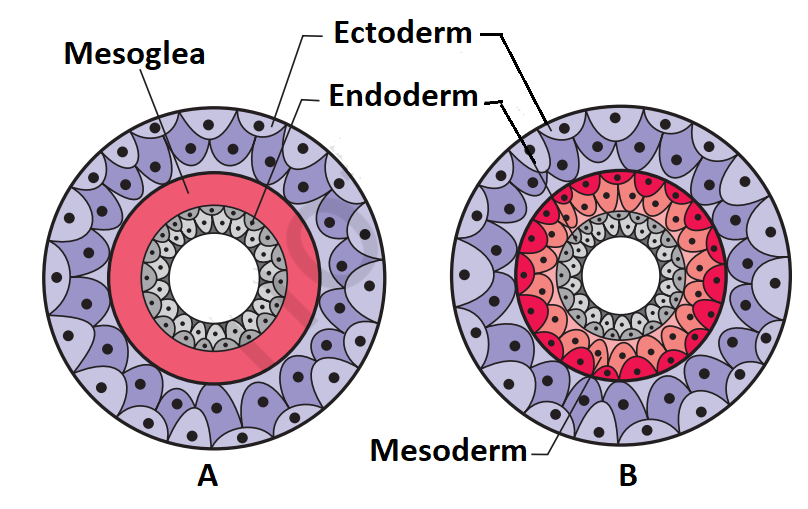 CorrectIncorrect
CorrectIncorrectHint
(d)
Correct answer 4th
❌ Not true for both:
1. Body will be bilaterally symmetrical
- A (diploblastic) animals like cnidarians show radial symmetry, not bilateral
- B (triploblastic) animals are generally bilaterally symmetrical.
2. Muscle will be well developed
-
Diploblasts (A) have basic epitheliomuscular cells—not complex, well-developed muscles . Triploblasts (B) do develop proper musculature from mesoderm.
3. A true coelom will be present
- A has no coelom.
- B may be coelomate, acoelomate, or pseudocoelomate, depending on the specific triploblastic animal.
-
Question 5 of 45
5. Question
1 point(s)Regarding bilateral symmetry:
I. Bilateral symmetry is the body plan where the body of the animal can be divided into two identical halves through any plane passing through the central axis of the body.
II. While Ctenophores and adult Echinoderms have bilateral symmetry, Annelida and Arthropods have radial symmetry.
In light of the above statements, choose the most appropriate answer from the options given below:CorrectIncorrectHint
(c)
-
Statement I: “Bilateral symmetry is the body plan where the animal can be divided into two identical halves through any plane passing through the central axis.”
-
❌ Incorrect — that definition fits radial symmetry, not bilateral.
-
-
Statement II: “While Ctenophores and adult Echinoderms have bilateral symmetry, Annelida and Arthropods have radial symmetry.”
-
❌ Incorrect — Ctenophores and adult echinoderms are radially (or biradially) symmetrical, and annelids and arthropods are bilateral
-
-
Question 6 of 45
6. Question
1 point(s)Flatworms will exhibit all the following except:
CorrectIncorrectHint
(d)
Coelom? ❌
They are acoelomate, meaning they lack any body cavity (coelom) -
Question 7 of 45
7. Question
1 point(s)Consider the given features:
A: Body cavity lined by mesoderm
B: The mesoderm present as scattered pouches in between the ectoderm and the endoderm
Select the correct option of animals having the features A and B :\(
\begin{array}{|l|l|l|}
\hline & \text { A } & \text { B } \\
\hline \text { 1. } & \text { Aschelminthes } & \text { Annelids } \\
\hline \text { 2. } & \text { Platyhelminthes } & \text { Ctenophores } \\
\hline \text { 3. } & \text { Arthropods } & \text { Molluscs } \\
\hline \text { 4. } & \text { Arthropods } & \text { Aschelminthes } \\
\hline
\end{array}
\)CorrectIncorrectHint
(d)
-
Question 8 of 45
8. Question
1 point(s)Examine the figures A, B and C. In which one of the four options all the items, A, B and C are correct?

\(
\begin{array}{|c|c|c|c|}
\hline
\text{No.} & A & B & C \\
\hline
1 & \text{Sycon} & \text{Euspongia} & \text{Spongilla} \\
\hline
2 & \text{Euspongia} & \text{Spongilla} & \text{Sycon} \\
\hline
3 & \text{Spongilla} & \text{Sycon} & \text{Euspongia} \\
\hline
4 & \text{Euspongia} & \text{Sycon} & \text{Spongilla} \\
\hline
\end{array}
\)CorrectIncorrectHint
(a)
-
Question 9 of 45
9. Question
1 point(s)In metameric segmentation:
I. The body is divided into segments only externally.
II. There is a serial repetition of at least some organs.CorrectIncorrectHint
(b)
I. “The body is divided into segments only externally.”
❌ This is incorrect. NCERT clearly states segments are both external and internal, not just external . -
Question 10 of 45
10. Question
1 point(s)The notochord:
I. is derived from embryonic mesoderm.
II. is present on the ventral side during embryonic development in chordates.CorrectIncorrectHint
(a)
II. “Present on the ventral side during embryonic development” — ❌ No.
It is explicitly stated that the notochord is formed on the dorsal side, positioned beneath the neural tube (which lies just under the dorsal surface), not on the ventral side -
Question 11 of 45
11. Question
1 point(s)The given figure shows broad classification of Kingdom Animalia based on common fundamental features. Which of the following can be true based on the information given in the figure?
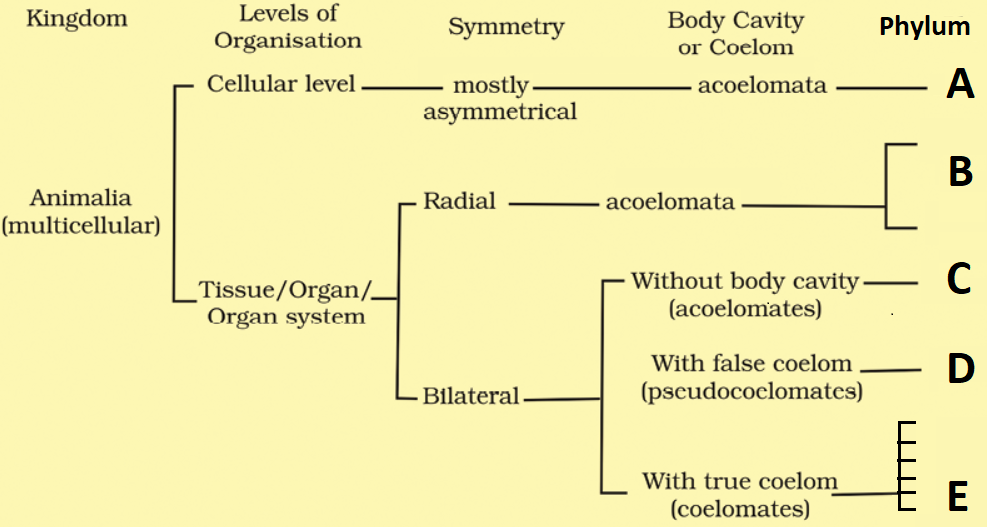
a. Sponges represent ‘A‘
b. ‘B‘ includes flatworms
c. Animals in ‘C‘ are triploblastic
d. Radial symmetry is seen in adults of animals in ‘D‘
e. Animals in ‘E‘ have a complete digestive systemCorrectIncorrectHint
(a)
b. ‘B’ includes flatworms ❌
Category B is radial, acoelomate—such as cnidarians and ctenophores. Flatworms are bilateral, acoelomate, and fit category C, not Bd. Radial symmetry is seen in adults of animals in ‘D’ ❌
Category D covers bilateral pseudocoelomates (e.g., nematodes). They exhibit bilateral symmetry, not radial. -
Question 12 of 45
12. Question
1 point(s)Which of the following is not a feature of Porifera?
CorrectIncorrectHint
(a)
Porifera are broadly described as mostly marine, but not exclusively
-
Question 13 of 45
13. Question
1 point(s)Water exits from a sponge through the:
CorrectIncorrectHint
(d)
-
Question 14 of 45
14. Question
1 point(s)Regarding the cell shown in the given figure:

I: The name Cnidaria is derived from this cell
II: The stinging capsule present in the cell is called as nematode
III: These cells help cnidarians in anchorage, defence and in capturing the preyCorrectIncorrectHint
(c)
Statement II: “The stinging capsule present in the cell is called as nematode”
❌ Incorrect. The correct term for the stinging capsule inside a cnidocyte is nematocyst (also known as cnidocyst), not nematode
-
Question 15 of 45
15. Question
1 point(s)Identify the incorrect statement regarding sponges:
CorrectIncorrectHint
(d)
-
Question 16 of 45
16. Question
1 point(s)Match each item in Column I with one in Column II and select the correct match from the codes given:
\(
\begin{array}{|l|l|l|l|}
\hline & \text { COLUMN I } & & \text { COLUMN II } \\
\hline \text { A } & \text { Spongilla } & \text { P } & \text { Sea-fan } \\
\hline \text { B } & \text { Euspongia } & \text { Q } & \text { Brain coral } \\
\hline \text { C } & \text { Gorgonia } & \text { R } & \text { Fresh Water sponge } \\
\hline \text { D } & \text { Meandrina } & \text { S } & \text { Sea-pen } \\
\hline \text { E } & \text { Pennatula } & \text { T } & \text { Bath sponge } \\
\hline
\end{array}
\)Codes:
\(
\begin{array}{|l|l|l|l|l|l|}
\hline & \text { A } & \text { B } & \text { C } & \text { D } & \text { E } \\
\hline 1 . & \text { T } & \text { R } & \text { P } & \text { Q } & \text { S } \\
\hline 2 . & \text { R } & \text { T } & \text { P } & \text { Q } & \text { S } \\
\hline 3 . & \text { T } & \text { R } & \text { Q } & \text { S } & \text { P } \\
\hline 4 . & \text { R } & \text { T } & \text { S } & \text { P } & \text { Q } \\
\hline
\end{array}
\)CorrectIncorrectHint
(b)
-
Question 17 of 45
17. Question
1 point(s)The given flow chart shows the classification scheme of sub-phylum Vertebrata. Identify A, B, C and D.
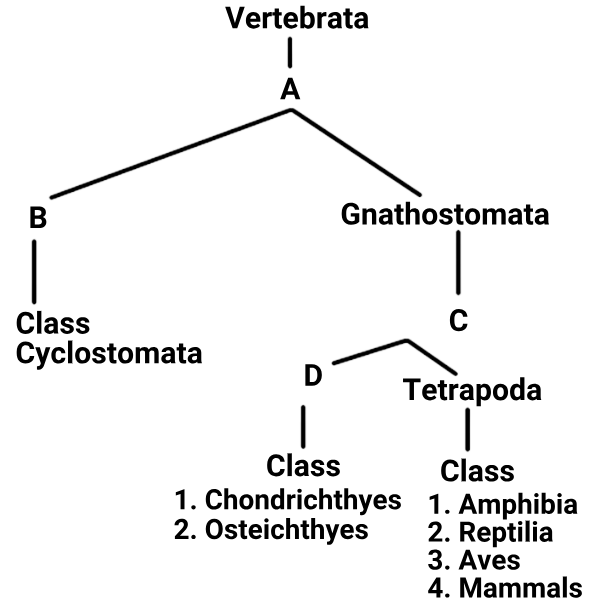
\(
\begin{array}{|l|l|l|l|l|}
\hline & \text { A } & \text { B } & \text { C } & \text { D } \\
\hline \text { 1. } & \text { Phylum } & \text { Cephalochordata } & \text { Urochordata } & \text { Protochordata } \\
\hline \text { 2. } & \text { Division } & \text { Agnatha } & \text { Super-Class } & \text { Pisces } \\
\hline \text { 3. } & \text { Phylum } & \text { Protochordata } & \text { Infra-class } & \text { Jawless fishes } \\
\hline \text { 4. } & \text { Division } & \text { Agnatha } & \text { Sub-division } & \text { Pisces } \\
\hline
\end{array}
\)CorrectIncorrectHint
(b)
-
Question 18 of 45
18. Question
1 point(s)Identify the incorrect statement regarding animals belonging to the Phylum Cnidaria:
CorrectIncorrectHint
(d)
Digestion involves both extracellular and intracellular processes, not exclusively intracellular
-
Question 19 of 45
19. Question
1 point(s)Consider the following statements regarding basic body plans in Cnidaria:
I. Polyp is sessile and cylindrical form as seen in Hydra and Adamsia.
II. Medusa is umbrella-shaped and free swimming form as seen in Aurelia.CorrectIncorrectHint
(c)
-
Question 20 of 45
20. Question
1 point(s)Which of the following is not a feature of Ctenophora?
CorrectIncorrectHint
(c)
-
Question 21 of 45
21. Question
1 point(s)Examine the figures A, B, C and D. In which one of the four options all the items, A, B, C and D are correct?
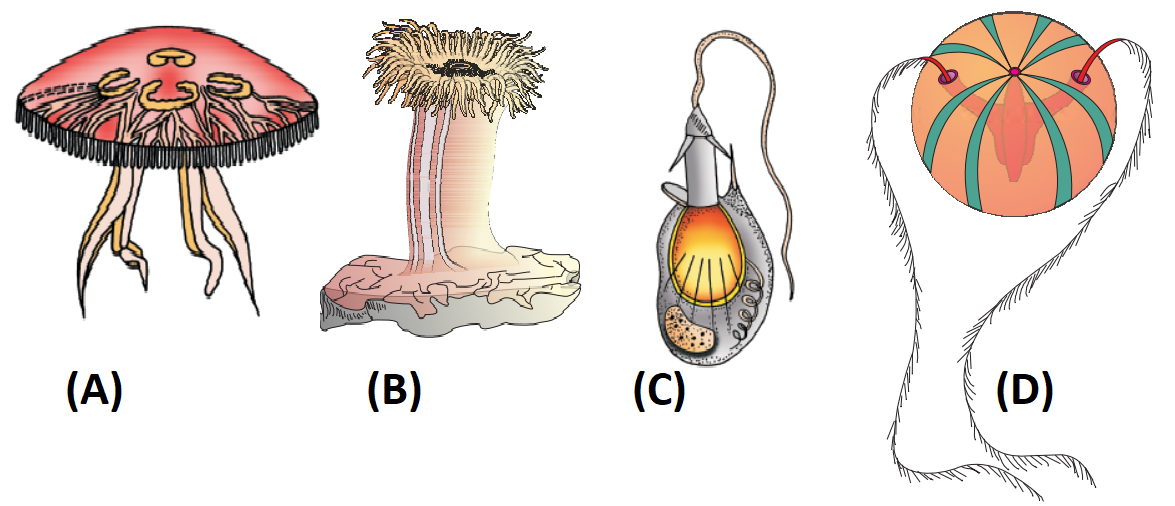
\(
\begin{array}{|c|c|c|c|c|}
\hline
\textbf{No.} & \textbf{A} & \textbf{B} & \textbf{C} & \textbf{D} \\
\hline
1 & \text{Pleurobrachia} & \text{Cnidoblast} & \text{Aurelia} & \text{Adamsia} \\
\hline
2 & \text{Aurelia} & \text{Adamsia} & \text{Cnidoblast} & \text{Pleurobrachia} \\
\hline
3 & \text{Cnidoblast} & \text{Pleurobrachia} & \text{Adamsia} & \text{Aurelia} \\
\hline
4 & \text{Adamsia} & \text{Aurelia} & \text{Pleurobrachia} & \text{Cnidoblast} \\
\hline
\end{array}
\)CorrectIncorrectHint
(b)
-
Question 22 of 45
22. Question
1 point(s)In Obelia:
a. both polyp and medusa forms exist during its life cycle
b. metagenesis, a sort of alternation of generation, is seen
c. polyps produce medusae sexually and medusae form the polyps sexuallyCorrectIncorrectHint
(b)
c. “Polyps produce medusae sexually and medusae form the polyps sexually” — ❌ Incorrect. In reality, polyps produce medusae asexually (by budding), while medusae form polyps sexually (through gamete fusion
-
Question 23 of 45
23. Question
1 point(s)Which of the following is not a feature of Ctenophora?
CorrectIncorrectHint
(c)
Presence of internal ciliated comb plates – ❌ False
-
Ctenophores have eight external rows of ciliated comb plates used for locomotion.
-
These comb plates are external, not internal
-
Question 24 of 45
24. Question
1 point(s)In Ctenophora:
a. body bears eight external rows of ciliated comb plates, which help in locomotion.
b. reproduction takes place only by asexual means.
c. digestion is both extracellular and intracellular.
d. sexes are separate.
The correct statements are:CorrectIncorrectHint
(a)
b. “Reproduction takes place only by asexual means.”
❌ False- Ctenophores reproduce only sexually.
- Asexual reproduction is not seen in them.
- Most species are hermaphroditic, though not all.
d. “Sexes are separate.”
❌ False (in most cases)- Most ctenophores are hermaphrodites, i.e., both male and female sex organs are present in the same individual.
- So, saying “sexes are separate” is not generally true.
-
Question 25 of 45
25. Question
1 point(s)Triploblastic organization, bilateral symmetry but lack of coelom will be seen in:
CorrectIncorrectHint
(a)
-
Question 26 of 45
26. Question
1 point(s)Members of the Phylum Platyhelminthes differ from animals belonging to Phylum Annelida and Phylum Arthropoda in:
CorrectIncorrectHint
(b)
Lacking a coelom” – ✅ Correct
-
Platyhelminthes are acoelomate (they lack a true body cavity).
-
In contrast:
-
Annelids are coelomates (true coelom present).
-
Arthropods are also coelomates, but with a reduced coelom (hemocoel).
-
-
So, this is the key difference.
-
Question 27 of 45
27. Question
1 point(s)Examine the figures A, B, C, D, E and F. In which one of the four options all the items, A, B, C, D, E and F are correct ?
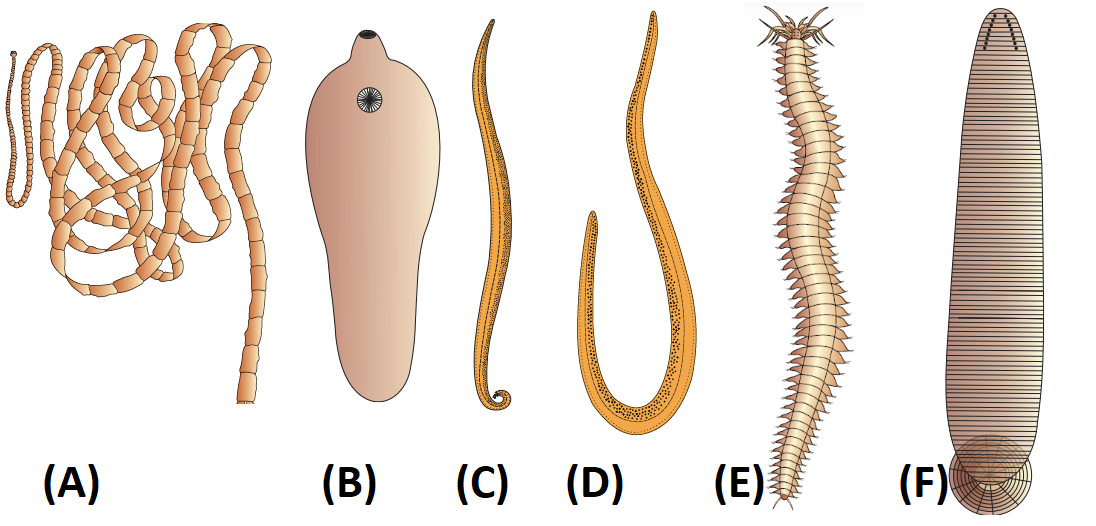 CorrectIncorrect
CorrectIncorrectHint
(d)
-
Question 28 of 45
28. Question
1 point(s)Ascaris is characterized by:
CorrectIncorrectHint
(d)
-
Question 29 of 45
29. Question
1 point(s)Body cavity is the cavity present between body wall and gut wall. In some animals, the body cavity is not lined by mesoderm. Such animals are called
CorrectIncorrectHint
(b)
-
Question 30 of 45
30. Question
1 point(s)Unlike Arthropods, Annelids:
CorrectIncorrectHint
(b)
-
Question 31 of 45
31. Question
1 point(s)Identify the incorrect statement regarding animals belonging to Phylum Annelida:
CorrectIncorrectHint
(d)
-
Question 32 of 45
32. Question
1 point(s)Examine the figures A, B, C and D. In which one of the four options all the items, A, B, C and D are correct ?
 CorrectIncorrect
CorrectIncorrectHint
(a)
-
Question 33 of 45
33. Question
1 point(s)Which of the following is not an Arthropod characteristic ?
CorrectIncorrectHint
(c)
They have open circulation
-
Question 34 of 45
34. Question
1 point(s)Consider the two statements:
Statement I: Planaria is a free-living flatworm and possesses high regeneration capacity.
Statement II: Hooks and suckers are present in parasitic flatworms.CorrectIncorrectHint
(c)
-
Question 35 of 45
35. Question
1 point(s)Animals belonging to phylum Chordata are fundamentally characterised by the presence of structure noted as A, B, C and D. Identify A, B, C and D .
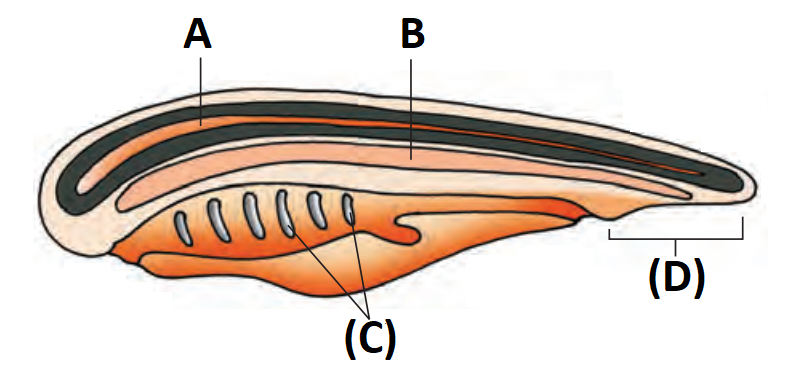 CorrectIncorrect
CorrectIncorrectHint
(b)
-
Question 36 of 45
36. Question
1 point(s)Consider the following statements regarding roundworms:
Statement I: Alimentary canal is complete with a welldeveloped muscular pharynx.
Statement II: An excretory tube removes body wastes from the body cavity through the excretory pore.
Statement III: They are dioecious and males are longer than females.
The incorrect statement is/are:CorrectIncorrectHint
(b)
III. Female is longer than Male
-
Question 37 of 45
37. Question
1 point(s)Identify the correct statements regarding arthropods:
I: They are bilaterally symmetrical, triploblastic, non-segmented and pseudocoelomate animals.
II: Arthropoda is the largest phylum of Animalia and includes more than \( 90 \% \) of all species on the earth that are named so far.
III: Insects are arthropods with body consisting of head, thorax and abdomen.CorrectIncorrectHint
(c)
I.
- Bilateral symmetry ✅
- Triploblastic ✅
- Nonsegmented ❌ → Wrong, arthropods are segmented.
- Pseudocoelomate ❌ → Wrong, they are coelomate (though the coelom is reduced and filled with blood = haemocoel).
- ✅ Conclusion: ❌ Incorrect
II.
So according to NCERT:
- It’s about 66%+ (two-thirds), not 90%.
- Hence, the “90%” makes the statement incorrect per NCERT.
✅ Conclusion: ❌ Incorrect
-
Question 38 of 45
38. Question
1 point(s)Examine the figures A, B and C. In which one of the four options, all the items, A, B and C are correct ?
 CorrectIncorrect
CorrectIncorrectHint
(c)
-
Question 39 of 45
39. Question
1 point(s)Identify the incorrect statement regarding Mollusca:
CorrectIncorrectHint
(c)
3. “Body is covered with a calcareous shell and is metamerically segmented with a distinct head, muscular foot, and visceral hump.”
❌ Incorrect
- While most molluscs do have:
- A calcareous shell ✅
- A head, muscular foot, and visceral hump ✅
- They are NOT metamerically segmented ❌
-
-
Metamerism (true segmentation) is seen in Annelida, Arthropoda, and Chordata, but not in Mollusca.
-
-
Question 40 of 45
40. Question
1 point(s)\(
\begin{array}{|c|l|c|l|}
\hline
& \text{COLUMN I} & & \text{COLUMN II} \\
\hline
\text{A} & \text{Insect reared for producing silk} & \text{P} & \text{Locusta} \\
\hline
\text{B} & \begin{array}{l}
\text{Mosquito acting as vector for Dengue} \\
\text{virus}
\end{array} & \text{Q} & \text{Bombyx} \\
\hline
\text{C} & \text{Gregarious pest} & \text{R} & \text{Limulus} \\
\hline
\text{D} & \text{Living fossil} & \text{S} & \text{Aedes} \\
\hline
\end{array}
\)Codes:
\(
\begin{array}{|l|l|l|l|l|}
\hline & \text { A } & \text { B } & \text { C } & \text { D } \\
\hline 1 . & \text { Q } & \text { S } & \text { P } & \text { R } \\
\hline 2 . & \text { Q } & \text { S } & \text { R } & \text { P } \\
\hline 3 . & \text { P } & \text { Q } & \text { R } & \text { S } \\
\hline 4 . & \text { R } & \text { P } & \text { Q } & \text { S } \\
\hline
\end{array}
\)CorrectIncorrectHint
(a)
-
Question 41 of 45
41. Question
1 point(s)A water vascular system is characteristically present in:
CorrectIncorrectHint
(c)
-
Question 42 of 45
42. Question
1 point(s)The number of correct statements regarding hemichordates from the given is:
I. A stomochord is present in the collar region
II. Circulation is of open type
III. Excretory organ is proboscis gland
IV. Development is indirectCorrectIncorrectHint
(d)
-
Question 43 of 45
43. Question
1 point(s)Identify the incorrect statement regarding bony fishes :
I: They have four pairs of gills which are covered by an operculum on each side.
II: Due to the absence of air bladder, they have to swim constantly to avoid sinking.
III: Skin is covered with placoid scales.
IV: Mouth is mostly terminal.CorrectIncorrectHint
(b)
II. ❌ Incorrect
- This statement is true for cartilaginous fishes (Chondrichthyes), not bony fishes.
- Bony fishes have an air bladder (swim bladder) that helps maintain buoyancy without swimming constantly.
III. ❌ Incorrect
- Placoid scales are found in cartilaginous fishes (e.g., sharks).
- Bony fishes have cycloid or ctenoid scales.
- So this is also incorrect.
-
Question 44 of 45
44. Question
1 point(s)Observe the following diagrams and tick the correct option with their respective classes :
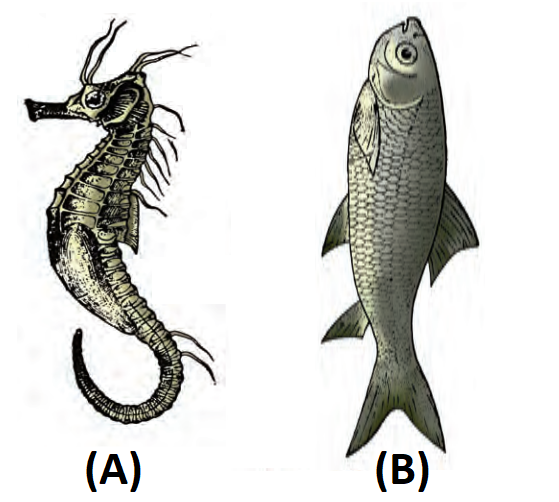 CorrectIncorrect
CorrectIncorrectHint
(a)
Fig. (A) Hippocampus Fig. (B) Cat/a
-
Question 45 of 45
45. Question
1 point(s)In birds:
a. the characteristic feature is the presence of feathers
b. forelimbs are modified into wings.
c. flight is present in all members.
d. hind limbs do not have scales.CorrectIncorrectHint
(d)
c.
❌ Incorrect
- While most birds can fly, not all birds are capable of flight.
- Examples: Ostrich, Emu, Kiwi, Penguin are flightless.
- So, this is not true for all members.
d.
❌ Incorrect
- Birds’ hind limbs (legs) typically do have scales, especially on the lower part of the leg and feet.
- These scales are epidermal and reptilian-like, supporting the evolutionary link with reptiles.